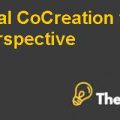
The Merger of Hewlett-Packard and Compaq (A): Strategy and Valuation Case Solution
Analysis
SWOT Analysis
In order to understand the situation clearly, SWOT analysis is performed below.
Strengths:
- Both companies have significant brand recognition and brand loyalty in IT industry with strong customer base and market share.
- HP is a dominant player within the printing and imaging industry in the UNIX market whereas,Compaq is famous for providing high quality PCs.
- Both companies have strong research and development department, which has led towards more innovative product offerings of both companies.
- Resource availability of both companies is tremendous along with significant financial resources to support the proposed merger.
Weaknesses:
- HP is facing the problem of lack of organic growth strategy whereas,Compaq does not have strong presence in UNIX market.
- Announcement of merger resulted in the decline in the HP’s share prices.
- Low support from the management such as Walter Hewlett’s opposition of the merger after accepting it in the meetings created a sense of uncertainty for the merger.
- Duplication of management systems and no direct distribution plan regarding the proposed merger.
Opportunities:
- A chance for HP to adjust itself to the changing trend.
- The probability to excel in different market segments rather than only Imaging and Printing.
- It can result in the new company being the market leader along with value creation in the existing and new products.
- HP’s core objective to provide end -o-end solution to the clients and its desire to regain its previous position in the PC’s and servers can be achieved.
- The merger of both the companies can have a major impact on the market.
- Both the companies have their own area of expertise, which combined, can prove to be a threat to the competitors.
Threats:
- The share price can decrease further after the opposition from HP.
- Both companies are operating in the IT industry and there is a changing trend in the technology therefore, the short life of technology is a serious threat for both companies.
- Projected loss as a result of merger.
- Acquisition risk cannot be ignored.
- Both the companies are facing strong competition from their peers as well as their industry margins are decreasing due to the economic downturn.
Analysis of the merger strategy to identify its effectiveness
Initially, the merger does not seem like a good decision as it resulted in a decrease in the share price and faced lots of criticism by analysts and opposition by many investors, which meant that most of the stakeholders were against the deal, which made this merger less attractive. In addition to this, there were cultural issues and pricing issues between both companies, and analysts assumed that these issues will go against the proposed merger therefore, initially this merger is supposed to be ineffective. However, the managements of both companies were firm in executing the deal and predicted long term benefits of economic growth and innovation. The objectives and long term focuses of both companies are very much aligned to facilitate the consumers with high quality products in the technology industry. HP’s management argued as to how it could generate strategic synergies, economies of scale and stronger market position........................
This is just a sample partial case solution. Please place the order on the website to order your own originally done case solution.













